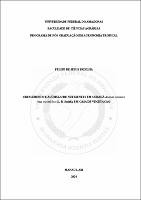| ???jsp.display-item.social.title??? |


|
Please use this identifier to cite or link to this item:
https://tede.ufam.edu.br/handle/tede/10941| ???metadata.dc.type???: | Tese |
| Title: | Crescimento e acúmulo de nutrientes em curauá Ananas comosus var. erectifolius (L. B. Smith), em casa de vegetação |
| Other Titles: | Growth and accumulation of nutrients in Curauá Ananas comosus var. erectifolius (L. B. Smith), in a greenhouse |
| ???metadata.dc.creator???: | Padilha, Felipe de Jesus  |
| ???metadata.dc.contributor.advisor1???: | Chaves, Francisco Célio Maia |
| First advisor-co: | Oka, Jaisson Miyosi |
| ???metadata.dc.contributor.referee2???: | Silva, Simone |
| ???metadata.dc.contributor.referee3???: | Sousa, Aline Ellen Duarte de |
| ???metadata.dc.contributor.referee4???: | Freitas, lávio Augusto de |
| ???metadata.dc.contributor.referee5???: | Ming, Lin Chau |
| ???metadata.dc.description.resumo???: | A espécie Ananas comosus possui uma variedade de morfotipos diferentes de plantas, das quais encontra-se o curauá, cujas fibras são utilizadas para fins industriais, porém pouco se sabe sobre as características fenológicas e nutricionais desta espécie. O objetivo deste estudo foi determinar as fenofases, crescimento e acúmulo de nutrientes de dois tipos de curauá (Ananas comosus var. erectifolius (L. B. Smith)) em casa de vegetação. O experimento foi conduzido em delineamento inteiramente casualizado, com variáveis dependentes de 9 períodos de avaliação [60, 120, 180, 240, 300, 360, 420, 480, 540 dias após o transplantio (DAT) das mudas], e três partes da planta (raiz, caule e folhas) com quatro repetições, sendo cada planta uma unidade experimental cultivada em vasos de 12 L, totalizando 40 unidades experimentais para cada tipo de curauá. Todas as plantas receberam a mesma dose de nutrientes. Foram avaliadas as características fenotípicas das plantas, além da altura, diâmetro do caule, número de folhas, área foliar e o conteúdo de nutrientes em cada parte da planta. Foram identificadas três fenofases para os dois tipos de curauá: a fase vegetativa do curauá branco (420 DAT) e curauá roxo (480 DAT), fenofase de florescimento do curauá branco (420 a 430 DAT) e curauá roxo (480 a 490 DAT) e a fenofase de produção do fruto do curauá branco de (430 a 540 DAT) e do curauá roxo de (490 a 540 DAT). As plantas cresceram de forma linear com maiores valores de crescimento para o curauá branco entre os 300 e 360 DAT e o curauá roxo entre os 360 e 420 DAT. As plantas tiveram incremento crescente de nutrientes, com maiores valores acumulados para potássio e nitrogênio nos dois tipos de curauá entre os macronutrientes e ferro e manganês entre os micronutrientes. Entre as partes da planta, os maiores acúmulos de nutrientes ocorreram nas folhas. O crescimento e o acúmulo de nutrientes nos dois tipos de curauá está relacionado ao tempo de cultivo da planta e ao período fenológico produtivo, onde há maior acúmulo de nutrientes em relação as demais fenofases. A série preferencial de acúmulo de nutrientes foi de K > N > Ca > Mg > S > P > Fe > Mn > B > Zn > Cu para os dois tipos de curauá ao final do experimento. |
| Abstract: | The species Ananas comosus exhibits a range of morphotypes, including curauá, which is utilized for industrial purposes. However, there is limited knowledge regarding the phenological and nutritional characteristics of this species. This study aimed to determine the phenophases, growth patterns, and nutrient accumulation of two types of curauá (Ananas comosus var. erectifolius (L. B. Smith)) in a controlled greenhouse environment. The experiment employed a completely randomized design with a factorial arrangement of 9 x 3, encompassing nine evaluation periods [60, 120, 180, 240, 300, 360, 420, 480, 540 days after transplanting (DAT) the seedlings] and three plant parts (root, stem, and leaves), with four replications. Each plant constituted an experimental unit, cultivated in 12 L pots, resulting in a total of 40 experimental units for each type of curauá. All plants received an identical nutrient dosage. Morphological characteristics were assessed, including plant height, stem diameter, leaf count, leaf area, and nutrient content in each plant part. Three phenophases were identified for both types of curauá: the vegetative phase for white curauá (420 DAT) and purple curauá (480 DAT), the flowering phase for white curauá (420 to 430 DAT) and purple curauá (480 to 490 DAT), and the fruit production phase for white curauá (430 to 540 DAT) and purple curauá (490 to 540 DAT). The plants demonstrated linear growth, with the highest growth rates for white curauá between 300 and 360 DAT and for purple curauá between 360 and 420 DAT. Nutrient accumulation increased progressively, with the highest values recorded for potassium and nitrogen among macronutrients, and iron and manganese among micronutrients in both curauá types. Notably, the greatest nutrient accumulation occurred in the leaves. The growth and nutrient accumulation in both curauá types were correlated with cultivation duration and the productive phenological period, during which there was a marked increase in nutrient accumulation relative to other phenophases. The preferential sequence of nutrient accumulation was K > N > Ca > Mg > S > P > Fe > Mn > B > Zn > Cu for both curauá types at the conclusion of the experiment. Logistic equations proved most suitable for characterizing curauá growth, while the sigmoid equation more accurately represented nutrient accumulation in the plants. |
| ???metadata.dc.subject.cnpq???: | CIENCIAS AGRARIAS |
| ???metadata.dc.subject.user???: | Ananas comosus var. erectifolius Curauá Fenosafes Desenvolvimento vegetal |
| Language: | por |
| ???metadata.dc.publisher.country???: | Brasil |
| Publisher: | Universidade Federal do Amazonas |
| ???metadata.dc.publisher.initials???: | UFAM |
| ???metadata.dc.publisher.department???: | Faculdade de Ciências Agrárias |
| ???metadata.dc.publisher.program???: | Programa de Pós-graduação em Agronomia Tropical |
| Citation: | PADILHA, Felipe de Jesus. Crescimento e acúmulo de nutrientes em curauá Ananas comosus var. erectifolius (L. B. Smith), em casa de vegetação. 2024. 88 f. Tese (Doutorado em Agronomia Tropical) - Universidade Federal do Amazonas, Manaus (AM), 2024. |
| ???metadata.dc.rights???: | Acesso Aberto |
| ???metadata.dc.rights.uri???: | https://creativecommons.org/licenses/by-nc-nd/4.0/ |
| URI: | https://tede.ufam.edu.br/handle/tede/10941 |
| Issue Date: | 30-Oct-2024 |
| Appears in Collections: | Doutorado em Agronomia Tropical |
Files in This Item:
| File | Description | Size | Format | |
|---|---|---|---|---|
| TESE_FelipePadilha_PPGATR.pdf | 2.7 MB | Adobe PDF |  Download/Open Preview |
Items in DSpace are protected by copyright, with all rights reserved, unless otherwise indicated.




